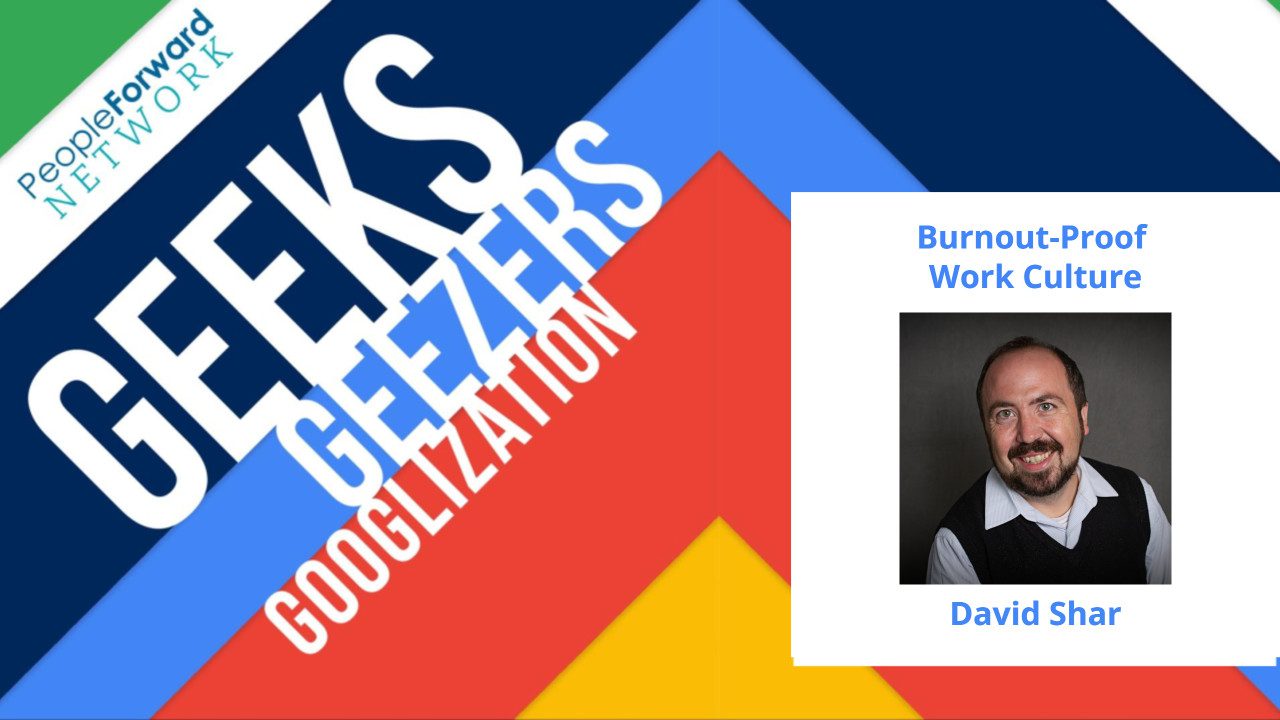
Build a Burnout-Proof Work Culture with David Shar
Burnout and work stress on the rise
Millions of workers are running on fumes. Many are running for the exit doors. Others are hitting the proverbial brick wall. simply succumbing to the chronic stress induced by the pandemic but perpetuated by living life and working in a Never Normal world. Sadly, burnout is on the rise. According to a recent Indeed report, 52 percent of all workers are feeling burned out, a 9% increase from pre-COVID days.
That’s not all.
A recent McKinsey report revealed that nearly 1 out of every 4 employees has moderate needs for counseling and psychotherapy. The World Health Organization estimates the impact of mental health symptoms on absenteeism, presenteeism, and loss of productivity is costing the global economy over $1 Trillion per year. Unfortunately, stress and burnout still carry a stigma and employers struggle to deal with it effectively.
In this Geeks Geezers Googlization episode, we tackle the topics of workplace burnout and meaningful work. We’ll hear from Burnout and Meaningful Work Expert David Shar who will share what burnout is, what causes it, and how leaders can fix it by helping workers find purpose in work and passion for their job.
In This Episode, You’ll Learn:
- Why burnout and stress is on the rise
- Why burnout is worse than ever
- How adaptability fits into burnout
- Gender and Generation differences in the workplace
- What the future of workplace looks like
David Shar’s Journey
David Shar is the founder of Illuminate PMC, He is a Keynote speaker, consultant, and corporate trainer. David is also an adjunct instructor at the University of Maryland’s Industrial/Organizational Psychology Master’s Program.
Is Workout Burnout Worse Than Ever?
Work stress and burnout are nothing new, according to host Ira S Wolfe. As an older Baby Boomer, he recalls living with volatility, uncertainty, complexity, and ambiguity quite often during his life. In fact, he feels life in 2022 is quite similar to growing up in the 60s and 70s when the Vietnam War dominated the news, inflation hit staggering highs and shortages of gas forced long lines, high prices, and rationing. So Wolfe asked Shar: “the news is very similar and we came out of it. Why is it so much worse this time for people?”(Wolfe, 00:09:22). Shar suggests that what makes this era so much different is the loss of control with the loss of support. The pandemic left millions of people feeling helpless. They felt abandoned by employers, the government, and healthcare. Isolation cut them off from their friends, family, and co-workers. People lost the level of deep connection that prior era’s needed to get through difficult periods like the one we’re experiencing now. Even the World Health Organization recognized the potential for a burnout crisis before the pandemic: “Burnout was recognized by the world health organization for the first time officially in 2019, only months before the pandemic” (Shar, 0010:36).
And Then the World Paused
Shar emphasizes that the burnout crisis was not caused by the pandemic; it has been increasing slowly over time. Then the world paused in March 2020 and it gave workers time to re-evaluate their professional and life choices. Shar notes how unique this is in a capitalistic society. Shar suggests that many workers feel like they are now playing the game of basketball without any baskets on the courts. For workers, COVID took away the workplace, the foundation of an ecosystem relied upon for over 150 years. Employees on the fly had to figure out how to play the game and they did. The longer the pandemic lasted, the more many of them learned to like it. When the call came to go back to walk, workers cried foul. This added to what Wolfe calls The Perfect Labor Storm and what Shar describes as a new workplace revolution.
Differences Between Men and Women in The Workplace
One size does not fit all and Shar does an excellent job at highlighting demographics that prefer remote work vs. in-office work. The solution: more workplace customization and equity such as we’re seeing with women and people of color who prefer the hybrid work environment. Many men, on the other hand, see a different future workplace. They would prefer to go back to the office.
Wolfe agrees, “the number one reason men wanted to go back to work was for career development and promotion.” (Wolfe, 00:26:03) A majority of men prioritize career development and how to stand out in the office. Ironically this leads to the very reason many women and people of color prefer remote work which is less “infected” by biases, microaggressions, and inequities. Remote and hybrid work therefore by default, creates a much safer environment to work in than a traditional corporate workspace.
Shar goes one step further: wage gap. “Men are much better at exaggerating,” warns Shar, “if not downright lying on their resume. They’re much more assertive in asking for more. There’s less of a stigma when they ask for more. (Shar, 00:27:41). Shar recalls when one of his old professors stated the best way to get promoted is to “get in with the power core,” which was not through outcomes but by in-person activities like lunch and golf.
Differences Between Gen Z, Millennials, and Baby Boomers
Shar’s research shows the conflict between how older generations and recent graduates feel about being in a corporate office on a day-to-day basis. Some recent graduates want to be at work and in an office. One reason is that “it’s hard to get that sense of community, [to] get in there and make a name for yourself,” (Shar, 00:33:44) But the jury was split because other younger people don’t feel a need to be tied to a location or even forced to commute.
Within Shar’s I/O Psychology class, his students seem to prefer the office workplace. He explains this by referring to the McClellan Motivator Theory which identifies three core motivators: Power, Accomplishment, or Affiliation. Shar shares “I was a little surprised as we went around the room they all put power on the bottom of the list.” (Shar, 00:34:44) For this group of young people. Affiliation is important as they see it as something evil and corruptible, pointing to a large amount of distrust in leadership.
What Does The Future of Work Look Like
To close out the podcast Co-Host Jason Cochran had one last question on what does the future of work look like in terms of mental health and burnout? Shar believes organizations that just dismiss the problem and force everyone back to the office will experience more burnout and stress-related problems. He highlights a few key points that help make workplace changes that will improve the mental health of employees.
- More flexibility of time and space.
- A greater understanding of what individuals in those jobs need and require.
- Organizations will have to address why so many people refuse to do high-paying labor jobs: it’s not about the bottom line but equity and feeling respected.
- Mass customization of jobs in the workforce, all leads back to flexibility.

